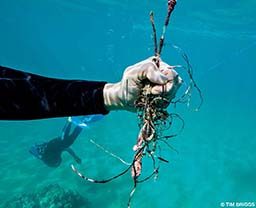Hawaii has a reputation for beautiful beaches, colorful reefs, balmy weather and pristine waters. If you have visited there, you know that Hawaii is paradise.
There are many reasons to visit the islands, but Hawaii’s legendary ocean life drew me in. Divers who have returned from trips to the Pacific talk about Hawaii’s tropical reefs, enthusiastically describing the coral cover, the fish, the sharks, the never-seen-before life that they saw there. They aren’t lying. You can see all these things and more.
Unfortunately, there is also a good chance you’ll find fishing gear debris marring the otherwise beautiful paradise. Fishing line stretches over reefs, diving under mounds and sheets of live coral that have overgrown the hooks and lures, wrapping around and through complex beds of finger corals, hooking under overhangs and disappearing into algae.

The fishing gear is ugly, and this malignant litter is corrupting the reefs that have helped build and support Hawaii’s once-pristine marine ecosystem. Even worse, marine life — especially green sea turtles and the endangered Hawaiian monk seal — can become entangled in this discarded gear. It cuts into their skin and can lead to potentially fatal infections.
Luckily, conservationists are fighting to keep Hawaii healthy and beautiful, and I saw them in action on a recent trip to Maui. The sun was still low in the sky on New Year’s Eve when I pulled into roadside parking in Kihei, an area in southwest Maui. A short walk down a grassy slope led to a popular beach, with a rich coral reef lying just beyond the shore.
I knew I had found the right people when I saw a group of divers donning wetsuits and retrieving their scissors, wire cutters and catch bags from their cars. These volunteers were with Turtle Island Restoration Network (TIRN), a global nonprofit organization that regularly cleans Maui’s reefs and beaches. Despite making a comeback, Hawaiian green sea turtles are still listed as threatened — and the hawksbill turtle is listed as endangered — on the U.S. Fish and Wildlife Service’s endangered species list.
Cheryl King, who for 15 years has organized groups of snorkelers to help clean reefs, free entangled turtles and care for hatchlings, became director of TIRN’s Hawaii program in October 2017. She has worked on turtle-related projects in Hawaii for almost 20 years. One of her current focuses is monitoring the sea turtle nesting activities on Lanai, a smaller island off the coast of Maui — 98 percent of which is owned by Larry Ellison, the billionaire former CEO of tech giant Oracle. King starts as many days as possible with time in the water, usually joining a volunteer group to clean the reef.

I got the opportunity to shadow some volunteers tasked with cleaning reefs off of Kamaole Beach, a popular spot for shore fishing and therefore an unfortunately reliable place to find entangled fishing line. It wasn’t hard to find gear littered across the reef. Fishing lines stand out as straight cuts through the complex curves of corals. Freediving down to cut away the lines from the coral usually leads to another set of dives as you follow the gear winding through the coral, often ending in threateningly large hooks. The volunteers joked that the oversized hooks showed wishful thinking on the part of the fishermen, as they were too large to catch anything found on this reef.
The reef itself remained relatively healthy, boasting abundant live coral, several nudibranchs and even a few turtles lazily rowing through the water or resting under overhangs and eyeing us with apparent disinterest. The volunteers commented on a lack of fish, however, something they’ve noticed in high-traffic tourist reefs over years of living on Maui.
Halfway through our expedition and about a hundred yards from shore, we came across a thick wire snaking through the reef. A 10-foot section bested our scissors and called for hardier wire cutters. Soon we had tracked the wire through 50 yards of reef, cutting as much of the wire as we could. Freediving to remove line is slow work in deep water, and it took many repeated dives to rid the reef of the wire.
Despite the grueling pace, in less than two hours the group removed 300 feet of line, 21 fishing weights (more than 3 pounds of lead), 12 hooks and lures, a compact disc, a sardine tin, fiberglass fragments of a boat hull and a pair of shorts. For perspective, they clean this reef once a week.

While I saw only one day in the life of this reef, the group says this was a below-average day of cleaning. Reefs such as Kamaole III receive this staggering amount of fishing gear and debris every week. It’s a “never-ending amount of fishing gear,” King says. “They could snorkel all day, every day, and never get to everything.”
During 61 coral reef cleanups all over Maui between October 2017 and January 2018, TIRN removed an astounding 22,857 feet — more than 4 miles — of fishing lines. They also removed 1,583 weights totaling 345 pounds along with 432 hooks, 571 swivels, 209 leaders, 106 bobbers and lures, and 555 pieces of trash.
For many volunteers who become involved with the group, cleaning reefs can be an addictive endeavor. The activity offers them the chance to snorkel and freedive while hunting for the next line to cut away from the reef. Green sea turtle sightings become almost commonplace, and the turtles will often come close to inspect the snorkelers. But reef cleaning goes beyond the thrill of being underwater. The community that comes together over shared passions for the ocean and its conservation are effusively optimistic and excited to help care for the reefs they’ve come to love. I have no doubt that TIRN’s efforts will help Maui’s reefs have a brighter, cleaner future.
| © Alert Diver — Q3 2018 |